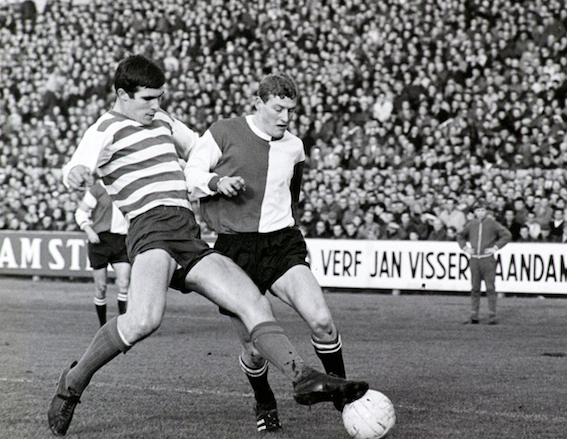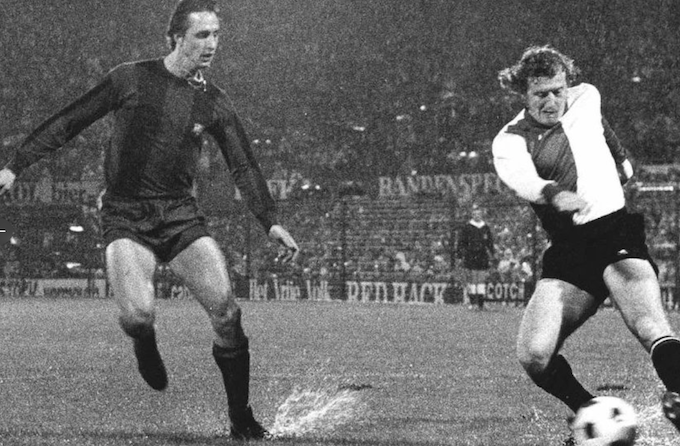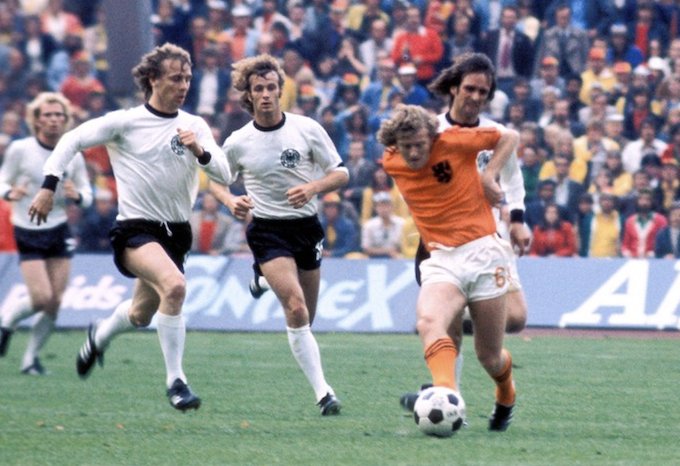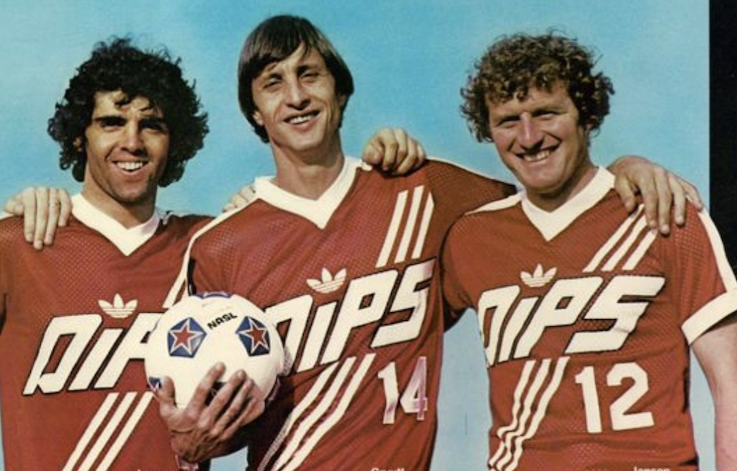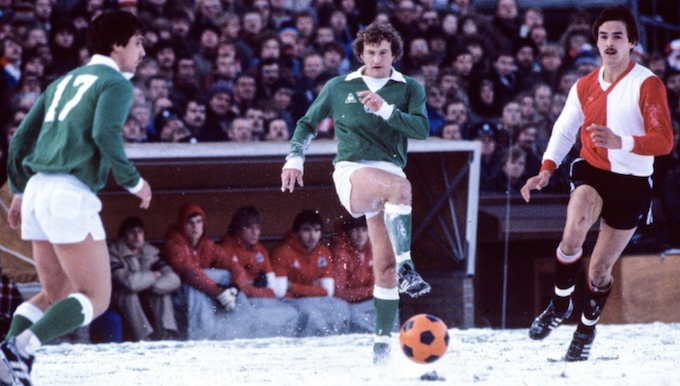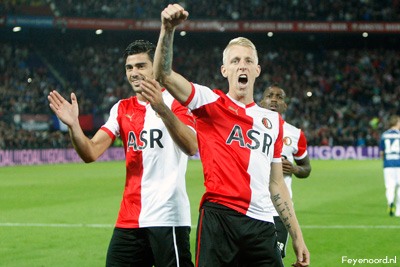Boy, what a sensational team they are developing up there… Van Beveren on goal. Now Van der Kuylen, Cruyff and Rensenbrink up front. Nico Reinders has been there for a while of course. Wim Suurbier as right back and now Wim Jansen joins in to anchor the midfield.
75 years is way too young, but Wim Jansen was struggling with Alzheimers for a while now and he was deteriorating really swiftly.
Wim Jansen is one of those unsung heroes of Dutch football. And that was mainly because he didn’t like being an “ununsung” hero…
But a hero he is. They’ll remember him fondly in Japan, in Glasgow, in Washington DC and in Amsterdam but mainly in Rotterdam (where the fans and the club will hold a memorial for him this coming Saturday in front of De Kuip Stadium).
He started his career like so many kids. But as opposed to most: Wimpie (little Wim) was not your typical rebel rousing streetwise rascal. His parents didn’t enjoy sports. And Wim was a fan of billiards and would always be in time home for supper. His personality was perfect, the ideal son-in-law. Feyenoord doctor Arbarbanel knows it for sure: “He’s a good kid but he will never make it at the top”.
Big Willem of Xerxes versus Little Wim of Feyenoord
When he is 13 years old, he is diagnosed with a knee problem. A “weak knee” is the diagnosis. And he was never to play again. Feyenoord even sent him away. And Wimpie decided to just play on the street, with his mates. Wim lives in the Old North of Rotterdam, where Feyenoord icon Coen Moulijn, the Messi like left winger of Feyenoord, lives. And Wimpie and his mates see their hero drive to the Kuip regularly, all in awe. But a year after Wim’s medical diagnosis, he returns to Feyenoord! He has grown and became stronger and his knee holds it all together well. Wimpie is captain of the C youth team and signs his first semi pro deal at 16 years old. He works the day in the office in the Rotterdam port and in the evening and in the weekend, he makes 30 guilders as a semi pro ( 12 euros). He usually goes to the match with his buddy Jan Boskamp (who would also make it to the NT squad for the 1974 World Cup) and Joop van Daele (who would become world famous for a week or so, as the match winner in the Feyenoord World Cup for teams win).
Wimpie belongs to the Feyenoord inventory, almost. He’s always there and he’s everywhere. When the president is asked in 1966 when a home grown player will make it big, he points at Wim Jansen: “There he is! That lad will be a big player one day”.
And he does make it into the first team, as so-called left inside forward ( in a 3-2-5 system). Coen Moulijn is still with the club and loves playing with Jansen: “I remembered him from the street where I lived. He was a real creative player but that disappeared when he got older. He’s the ultimate team player. A passer of the ball. I loved playing with Jansen more than with Van Hanegem. Wim was the master of one touch and would always launch me. Van Hanegem was harder to predict. And Wim is a nice guy, you know.” And Wim was in awe that he was actually playing the same team as his big idol.
Feyenoord youth team wins title, with Wim Jansen below far right. Next to him Jan Boskamp. Second from left, sitting, Joop van Daele, the later matchwinner of the World Cup match
Jansen would play for Feyenoord 1 for 15 years and he would form the core of the new Feyenoord, with Ove Kindvall from Sweden, Ruud Geels and Rinus Israel. When Willem van Hanegem is signed a year later, the perfect midfield couple is born. Jansen would become the first Feyenoord full pro and would develop what he called “blind communication” with Van Hanegem. The two acted as twins and even bought homes practically next ot each other in my home town of HI Ambacht.
Feyenoord and the players realised that now, the game was about the results. And about winning points so the players would make more. Rinus Israel became Jansen’s mentor. “Could I ask for a better one?” With De Kromme, Jansen developed this telepathic bond. Willem van Hanegem: “He was so good. Wim could play anywhere on the pitch. He couldn’t be a goalie, though… too small. But Wim would always pass the ball with intelligence, with purpose. In today’s game, you’d probably compare him to Paul Scholes, or Jorginho or Kimmel. Smart, effective… always passing and moving.”
In the 60s, Georg Kessler selects him for the Dutch NT where he plays next to Cruyff and Willy van der Kuylen. Kessler: “Wim Jansen should be the role model for today’s youths. Not Cruyff!” The 20 year old midfielder is not too comfortable in the Dutch midfield, as he is surrounded by Ajax players, such as Bennie Muller, Henk Groot, Piet Keizer and Johan Cruyff. When Oranje fails to qualify for the Euros in 1968, Jansen loses his spot. The 1970 World Cup and the 1972 Euros are also missed by the Dutch and Jansen would only play two internationals in those early 70s. The coach – Fadrhonc – usually picks a midfield with Neeskens, Van Hanegem, Gerrie Muhren or Theo de Jong.
Jansen is not happy but will focus his efforts on his club. In 1970 he wins the European Cup and the World Cup and Willem van Hanegem and Wim Jansen (big Wim and Wimpie) conquer the world.
Against his friend Johan, when Barca met Feyenoord
Ernst Happel, the Austrian former star and current Feyenoord coach, becomes his mentor in tactics. Jansen realises that the pass and move game is the key game. “Taking on players and dribbling is nice but it does result in loss of possession. The ball is always faster than the player, so by passing and moving you can outsmart any opponent.” Happel calls Jansen the accelerator in the team. Where Van Hanegem sometimes slows the game down (on purpose) or waits for the perfect timing for a cross, Jansen is a one-touch player who moves the play relentlessly.
Wim Jansen is the King of Playing Simple. As JC once said: football is a simple game, but to play simple is the hardest thing there is. He is also the King of Silence. He loves anonymity, he loathes publicity. Famously, Johan Derksen once traveled the world with him, visiting famous youth academies and Jansen would go on and on about football, share investing and The Beatles (his three passions) but when Johan needed to interview him formally, Jansen would not be able to answer more than ‘yes’ or ‘no’. A very private man.
When Feyenoord plays their semi finals against AC Milan in 1970, Jansen completely nullifies star player Gianni Rivera and scores a Ziyech type goal. Feyenoord would go on to beat Celtic for the trophy and Jansen’s name is internationally settled. In 1974 he’d win the UEFA Cup with Feyenoord, beating Spurs.
When Oranje travels to the World Cup 1974, coach (supervisor) Rinus Michels is plagued by injuries. When Drost, Israel, Laseroms, Mansveld and Hulshoff all fall away for the CB role, Michels (Cruyff?) picks Arie Haan. And this is the impetus needed for Jansen, as he is picked as the third midfielder, next to Van Hanegem and Neeskens (Gerrie Muhren is also injured). “I am grateful to be part of this and if I can make minutes, it would be awesome.” Well, Wim
Jansen played every minute and was one of the outstanding players – with Van Hanegem, Cruyff, Rensenbrink and Rep – of this magical Oranje team.
In that fatal WC 74 finals…
Through his games with the NT, Jansen struck a deep friendship with Cruyff. The late master of the game said repeatedly in interviews that Jansen was the only player he knew that shared his football insights and ideas about football tactics. Even Willem van Hanegem famously said that when JC and Wimpie start debating football, he’d go to the bar for another glass of wine, as it became hocus pocus for him!
Four years later, Jansen is also part of the squad managed by Ernst Happel winning silver again (losing gold…?) in Argentina.
Back in Holland, Feyenoord’s management is making (financial) mistake after mistake and the one richest club on the planet (!) is fading. When Jansen gets into conflict with the board and coach Jezek, Jansen decides to move away.
When his buddy Cruyff moves to Washington Diplomats, Wim Jansen decides to follow him.
The news drops like a bomb. “Shocking Farewell” is the headline of the AD newspaper. “I am maybe a bit quiet, but I have an opinion and I’m headstrong. I can’t stand for what happened. I am gone and I don’t think I’ll ever come back here.” When asked about the media mayhem that ensued, he said: “Don’t worry, in 2 weeks time, I’ll be forgotten.”
He wouldn’t last more than one season. “Life in America is wonderful, but the football here…they simply don’t get it.”
Juan Lozano, Johan Cruyff, Wim Jansen
So now what? Well, Johan Cruyff has the answer. He is now technical coordinator at Ajax and he advises the club to sign Jansen. Ajax has a number of great young talents – as per usual – but defensively, it’s like Swiss Cheese. Ajax is 8th in the table with a tremendous number of goals conceded.
Jansen made his debut for Ajax in December 1980. In De Kuip. Against Feyenoord. And the most famous ice-ball ever takes the headlines as an angry Feyenoord supporter throws the iceball towards the players when they start their warming up. The ice-ball hits Jansen in the eye and damages his cornea. He would try to play, for 15 minutes but was subbed when he wasn’t able to see what was happening too well. To put insult to injury, his future son-in-law Stanley Brard decided to take him out with a fierce tackle as well and that was it. Wimpie went from Mr Feyenoord to “dog-dick” (hondelul) in a heartbeat.
Jansen here right after being hit by the ice-ball
But Jansen is no push over. He would stay another season and mentor youngsters like Frank Rijkaard, Vanenburg, Kieft and Olsen. In that second season, the maestro himself puts his boots on again too and with Soren Lerby in midfield, Cruyff as false 9 and Jansen managing it from the back with Rijkaard, Ajax and Wim Jansen won the title.
Wimpie tried it for 15 minutes in his debut vs Feyenoord
He starts to think about life after his active career and he starts to collect information. Intelligence. He’s basically a collector. He collects shares, stamps and now he started collecting information about training practices, about nutrition, the working of the mind, and more. His database and archives become famous and more and more coaches and reporters find the way to his home to dive in Jansen’s footballing brain. When Feyenoord contacts him to come and coach the youth, the love for his club is re-kindled and Jansen would start a whole new phase in his career.
More in part 2…


